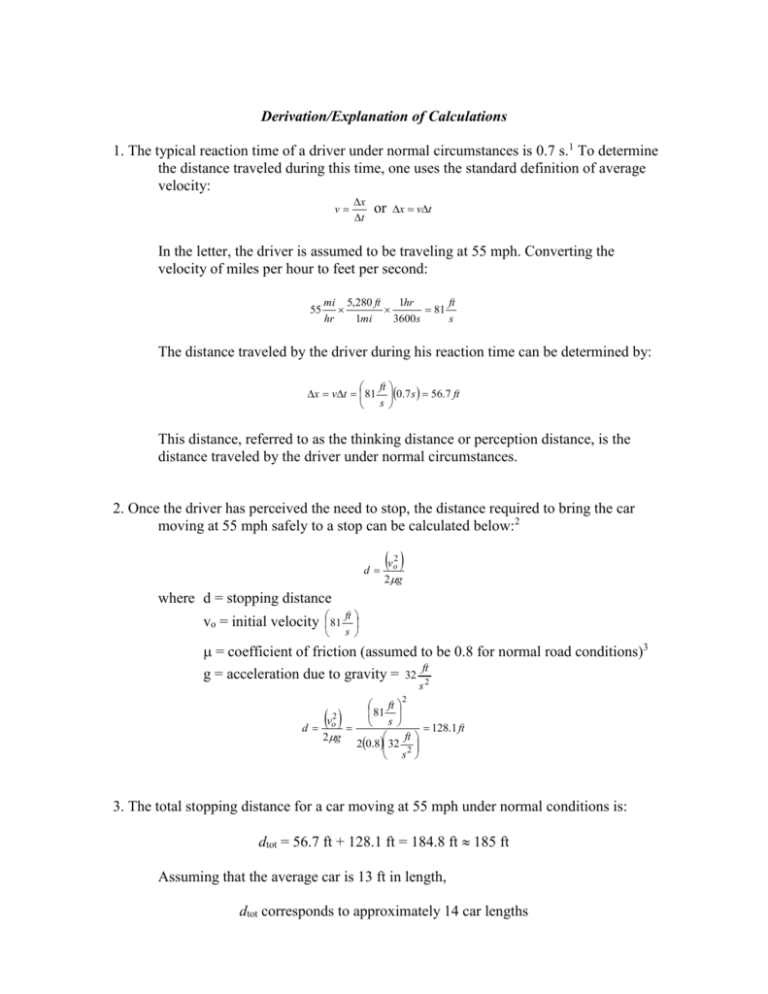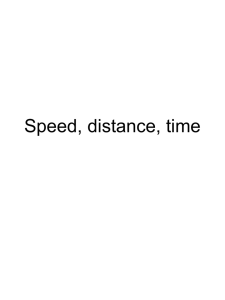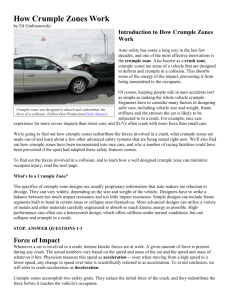Derivation/Explanation of Calculations
advertisement

Derivation/Explanation of Calculations 1. The typical reaction time of a driver under normal circumstances is 0.7 s.1 To determine the distance traveled during this time, one uses the standard definition of average velocity: x v or x vt t In the letter, the driver is assumed to be traveling at 55 mph. Converting the velocity of miles per hour to feet per second: 55 mi 5,280 ft 1hr ft 81 hr 1mi 3600s s The distance traveled by the driver during his reaction time can be determined by: ft x vt 81 0.7 s 56.7 ft s This distance, referred to as the thinking distance or perception distance, is the distance traveled by the driver under normal circumstances. 2. Once the driver has perceived the need to stop, the distance required to bring the car moving at 55 mph safely to a stop can be calculated below:2 d v 2 o 2 g where d = stopping distance vo = initial velocity ft 81 s = coefficient of friction (assumed to be 0.8 for normal road conditions)3 g = acceleration due to gravity = 32 ft2 s v d 2 o 2g 2 ft 81 s 128.1 ft ft 20.8 32 2 s 3. The total stopping distance for a car moving at 55 mph under normal conditions is: dtot = 56.7 ft + 128.1 ft = 184.8 ft 185 ft Assuming that the average car is 13 ft in length, dtot corresponds to approximately 14 car lengths 2 4. An intoxicated driver drives with an impaired reaction time, estimated to be 2 seconds. This value does depend on the person, the amount of alcohol consumed, and the time elapsed between alcohol consumption and driving. The thinking distance using the impaired reaction time can be calculated using the equation as used above: ft x vt 81 2.0s 162.0 ft s The total stopping distance required for an impaired driver is: dtot = 162.0 ft + 128.1 ft = 290.1 ft 290 ft Again, assuming that the average car is 13 ft in length, dtot corresponds to approximately 22 car lengths 5. Comparing the two total stopping distances, an additional 290 ft – 185 ft = 105 ft ( 8 car lengths) is required to stop the car under impaired conditions. 6. The driver is moving at a speed of 55 mph ( 81 ft ). To find the height from which an s object had to be dropped to attain a free-fall velocity equivalent to the driving speed, one must first determine the time required for an object in free-fall to reach such a speed. Using the free-fall equation for velocity: ft 81 v s 2.5s v gt t g 32 ft s2 The height from which the object would be dropped can be found from the equation: y 1 2 1 ft gt 32 2 2.52 100 ft 2 2 s Assuming a single story of a building is approximately 12 ft, then the driving speed corresponds to the speed of an object attained when dropped from a 100 ft 8stories ft 12 story 3 7. Determining the impact force of a driver originally moving at 55 mph slamming into a tree is a difficult task and depends upon a number of different factors, including: 1) the size of the driver; 2) the surface conditions of the road; 3) area of contact between the front end of the colliding car and the tree; 4) the type of seatbelts present in the car and whether they were used properly; 5) the presence of airbags and whether they were deployed properly; 6) the extent and total depth of penetration as a result of contact damage; and, 7) the presence and location of crumple zones, regions in the front and/or rear sections of a car typically found in modern cars, that are designed to crumple or collapse during a collision. The crumple zones in a car absorb energy transferred during a collision, lengthening the time of impact and thus decreasing the impact force inflicted upon the driver. Please note that these calculations are based on the fundamental laws and principles of physics which can be directly applied to the scenario of a car accident. However, the equations used in these calculations are only as good as the information input into them. Some variables such as driver weight, car weight, and the coefficient of friction of road surfaces can be approximated to a reasonable certainty. However, other variables such as rigidity of the car (ability to withstand significant forces), the contribution of any braking prior to collision, and an individual’s reaction time are much more difficult to factor into the equations. The calculations presented in the letter are designed to provide ballpark approximations of the physics involved in motor vehicle accidents. A physics teacher could leave it to his/her students to explore the impact of these physics laws and principles by investigating different sizes/weights of cars, different weights of drivers, different initial speeds of the car, and different reaction times due to excessive alcohol consumption or possibly other distractive behaviors such as cell phone usage.


